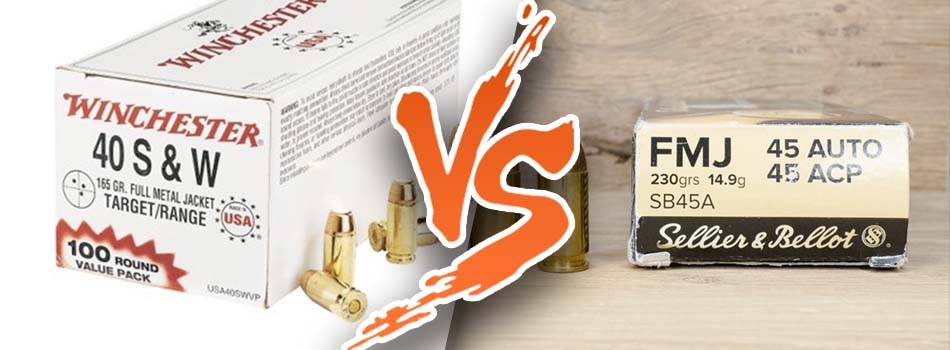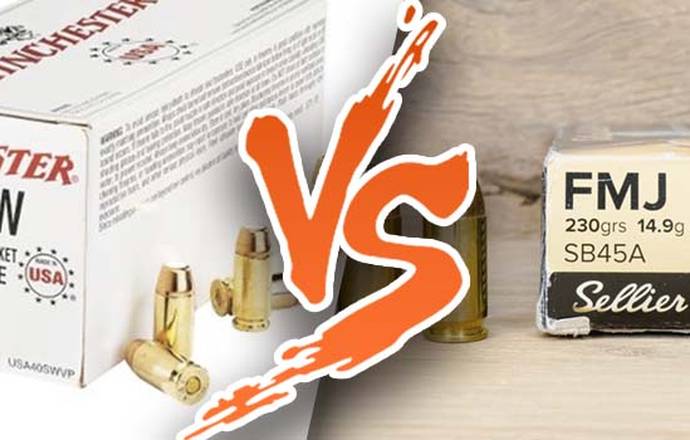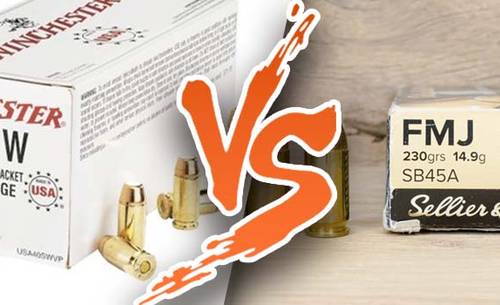


Table of Contents
Selecting the appropriate caliber of ammunition is a pivotal decision for both new gun buyers and seasoned firearm aficionados. Whether you are a newbie to the wide and wild world of firearms or this isn’t your first rodeo, it’s very important to learn the differences between the .40 and .45 calibers.
Craft Holster wants to provide you with some essential insights here in order to assist you in navigating the complex firearms landscape.
40 S&W VS 45 ACP
The .40 S&W and .45 ACP calibers are standout choices within the firearms community, each having distinct attributes and applications. A deep dive into the specifics of these calibers is indispensable for making a choice that aligns with your individual needs and shooting goals.
We’ll break down the distinguishing features of the .40 and .45 calibers, from their ballistic capabilities to their effectiveness in various shooting contexts. In the end, you should possess a much better understanding of how these two calibers compare, enabling a well-informed decision in your ammunition selection process.
For those in search of the perfect holster to accompany their chosen firearm, exploring Craft Holsters’ extensive selection can enhance your carrying experience.
With options tailored to a wide array of gun models, Craft Holsters ensures your firearm is secure, accessible, and comfortably positioned whenever you need it.
THE SKINNY ON THE SHOOTY: 40 VS 45
To accurately compare the .40 S&W and .45 ACP calibers, it’s essential to examine their ballistic performance, stopping power, and overall efficacy in practical scenarios.
BALLISTIC PERFORMANCE
The .40 S&W caliber is often noted for its higher velocity and flatter trajectory—attributed to its relatively smaller bullet diameter. This characteristic potentially gives the .40 caliber a little extra pep in terms of speed and precision over extended ranges. A good example of this is a personal favorite of mine: the Glock 27 (Gen 5).
On the other side of the debate, the .45 ACP is known for its heavier bullets, capable of delivering substantial energy upon impact, a quality that has solidified its popularity among many gun enthusiasts.
On the other side of the debate, the .45 ACP is known for its heavier bullets, capable of delivering substantial energy upon impact, a quality that has solidified its popularity among many gun enthusiasts.
STOPPING POWER
The concept of stopping power is integral to understanding a bullet's efficacy in neutralizing threats. The .45 ACP caliber is lauded for its exceptional stopping power, driven by its larger, heavier projectiles that can inflict significant wound cavities upon impact. Such capability is a big factor in self-defense scenarios where swift incapacitation is paramount. Meanwhile, the .40 S&W, with its higher velocity and streamlined trajectory, still commands formidable stopping power, making it a preferred option (historically) among various law enforcement bodies.
VIVE LA DIFFERENCE
Grasping the ballistic nuances and stopping power of both the .40 and .45 calibers is vital for tailoring your ammunition choice to your specific shooting preferences. Whether prioritizing velocity and accuracy or the sheer force of impact, each caliber presents distinct advantages suited to diverse shooting demands.
40 VS 45: RECOIL AND HANDLING CONSIDERATIONS
MANAGING RECOIL
Your recoil experience between .40 and .45 caliber firearms is a key factor to consider.
- Generally, .40 caliber handguns exhibit a sharper and more pronounced recoil, which could affect precision and the speed of executing follow-up shots.
- In contrast, the .45 caliber is known for its more gradual and controllable recoil pattern, aiding shooters in maintaining aim after discharging a round.
Recognizing how recoil influences your handling and shooting efficiency is vital in deciding which caliber aligns with your preferences.
ERGONOMICS AND SHOOTING COMFORT
Regardless of what kind of ammo you decide to use—.40, .45 or otherwise—handling differences between firearms and their inherent ergonomics, plus shooting comfort, is going to be a factor.
- The .40 caliber pistols often feature smaller grips due to the slimmer bullet, which might impact control and comfort, particularly for individuals with larger hands.
- 45 caliber handguns typically boast larger grips, enhancing ergonomics and providing a more satisfying hold for various shooters.
The weight of the firearm also contributes to its handling, with heavier models potentially reducing felt recoil and increasing steadiness during firing.
Whether your focus is on mastering recoil for better accuracy or prioritizing ergonomic comfort for enjoyable shooting sessions, understanding these distinctions between the .40 and .45 calibers is essential in making a choice that suits your shooting style.
45 VS 40: AVAILABILITY AND COST CONSIDERATIONS
The debate between .40 and .45 calibers often extends to ammunition availability and cost, with each caliber offering unique benefits and committed adherents. Here's a closer look at these considerations to aid in any decision-making process you choose.
MARKET ACCESSIBILITY
As of publishing, the market currently presents a robust availability of both .40 and .45 caliber ammunition, mirroring their popularity and sustained demand among gun owners. This ensures a variety of choices for sourcing ammunition, accommodating different preferences with a range of brands and types.
COST DYNAMICS
The cost of ammunition for both .40 and .45 calibers can vary, influenced by several factors, including:
- Brand
- Quality
- Current market trends
Typically, .40 caliber rounds may be slightly more economical than their .45 counterparts. Moreover, purchasing ammunition in bulk can offer cost savings for both calibers, presenting an opportunity for shooters to economize while stocking up.
THE BOTTOM LINE OF MARKETS AND COSTS
Ultimately, while both .40 and .45 caliber ammunitions are accessible within the market, the decision between them often hinges on individual preference and financial considerations. Whether leaning towards the swift .40 or the powerful .45, evaluating both availability and cost is crucial in selecting the caliber that best aligns with your specific shooting requirements.
MAKING THE CHOICE: .40 VS .45
PERSONAL PREFERENCES AND USAGE
The decision between .40 and .45 calibers is deeply personal, hinging on your specific needs and how you intend to use your firearm.
Whether your focus is on self-defense, target practice, or a combination of both, your unique shooting skills also play a crucial role.
- The .40 caliber, known for its manageable recoil and swift velocity, often appeals to those desiring a compromise between firepower and precision.
- The .45 caliber, with its notable stopping power and larger projectile size, stands out for self-defense scenarios where deep penetration is paramount.
Knowing your firearm's primary purpose and the attributes you value most—accuracy, strength, or handling ease—should clarify your options.
FINAL INSIGHTS: .45 VS .40 CALIBER
Ultimately, the choice between .40 and .45 calibers boils down to what you prioritize for your shooting experience. Each caliber presents distinct benefits and trade-offs: the .40 caliber strikes a harmonious balance of force and manageability, whereas the .45 caliber is renowned for its formidable stopping ability and penetration depth.
Selecting the appropriate ammunition is critical for achieving peak performance and ensuring safety. Deliberate on your shooting style, the intended application of your firearm, and your comfort with each caliber’s characteristics. An informed decision, rooted in your personal preferences, guarantees your firearm will fulfill its role effectively in any scenario.
THE BOTTOM LINE
In the comparison of .40 vs .45 calibers, both arguably have their unique advantages and factors that can’t be overlooked. The .40 S&W excels with faster bullets and a gentler recoil, while the .45 ACP delivers powerful impacts at a measured pace.
Choosing the ideal ammunition for your needs necessitates a thoughtful evaluation of ballistic properties, recoil sensations, and stopping power. Making a well-informed choice is paramount, ensuring the selected caliber perfectly matches your preferences and shooting demands. Whether you're navigating the firearm market for the first time or you're a veteran gun enthusiast, grasping the differences between .40 and .45 calibers is crucial for selecting wisely.
THE RIGHT HOLSTER FOR THE JOB
For those seeking the perfect accessory to complement their chosen firearm, consider the top-notch array of options at Craft Holsters for all your carry needs.
With designs meticulously tailored to fit numerous gun models, Craft Holsters enhances your carrying experience, blending security, accessibility, and comfort seamlessly.
DO YOU FANCY SOME MORE LIGHT READING? THEN CARRY ON WITH THESE ARTICLES
10MM VS 40: A CALIBER FACE-OFF
38 SPECIAL VS 357: REVOLVER RIVARLY
